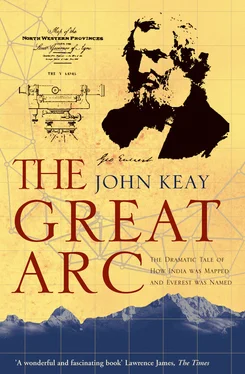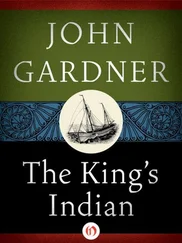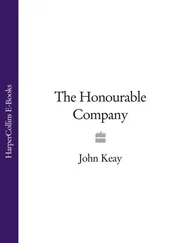Behind a street frontage of tented tea-stalls and tyre-repair shops a game of cricket was being played on a piece of waste land. It was our third point of call. Dodging the worm castings of human excrement which dotted the pitch like daisies, we trailed round the outfield towards a small whitewashed mosque. According to a report of 1929 Lambton’s grave had been joined by others and the spot consecrated as a Christian cemetery. Since no such place now existed in Hinganghat’s collective memory, and since, apart from Christians, only Muslims bury their dead, Mr Sebastian thought that the Maulvi, the local prayer-leader, might be able to help. Yes, said the Maulvi, there had been Christian tombs in what he called the Muslim cemetery, and although the hallowed ground had lately been built on by squatters, two were still intact.
One, mysteriously known as ‘the Belgian’s Stone’, turned out to be an obelisk within a circular walled enclosure which now served the squatter colony as a central urinal. The other was just a plain oblong plinth with the raised outline of a casket on its surface. Children used it for climbing on. There was no headstone and the whole sepulchre had at some point been encased in mortar. Into this mortar, when wet, someone had written three lines of text with a finger. The letters were ill-formed and were much too large ever to have conveyed more than the most basic information. There might originally have been twenty, and they looked to have been copied, perhaps from an earlier inscription, by someone not confident with Roman script. The mortar was now crumbling so badly that barely half were legible. But the ‘L’, ‘A’, ‘M’ and ‘B’ running along the top line were still clear. So was the word ‘DATE’, an annoyingly superfluous survival. It was followed by the three numerals ‘1’, ‘7’ and ‘6’, at which point the mortar had broken away.
If this date was to be read as seventeen-sixty-something, it was wrong. There could hardly be any question that this was indeed Lambton’s resting place, but he died in 1823. Moreover, seventeen-sixty-anything was rather early for a European grave in such an out-of-the-way place. It occurred to me, therefore, that it must be a birth date. On slender evidence Lambton’s birth is usually given as 1753. This would make him fifty when he started on the Great Arc, sixty-six when Everest joined him in Hyderabad, and an impressive but improbable seventy when he died. He was still in the field at the time, indeed looking forward to carrying his triangles on to Agra in the north of India, another two years’ work at least. Amongst Europeans exposed to India’s lethal climate seventy-year-olds were as rare then as centenarians today. A working seventy-year-old would have been a great curiosity and would certainly have attracted much contemporary comment. On the whole, then, I was ready to give the tomb the benefit of the doubt. Sometime in the early 1760s seemed a more plausible birth date than 1753. It also disposed of a decade-long void when Lambton, supposedly in his twenties, unaccountably disappears from the record.
Where he was born is more certain. It was on a debt-ridden farm in the North Riding of Yorkshire whose plight would oblige him to make the support of his impoverished parents an important career consideration. Early promise in mathematics won him a place in a grammar school and, in 1781, an Ensign-ship in an infantry regiment. With the 33rd Foot he promptly sailed for the war (of Independence) in America and was there promptly taken prisoner at York Town. After release he was ordered to the then wilderness of New Brunswick on the north-eastern seaboard. He helped divide and apportion its land amongst British loyalists displaced by the American victory, and was involved in surveying and delineating what now became the boundary between British Canada and the United States.
Nine years later, apparently as a result of an oversight, he was still in New Brunswick and still an Ensign, although drawing additional pay as a civilian Barrack-Master. A hint, however, that his years in the wilderness were numbered came in 1793 when he was unexpectedly promoted; ‘to his astonishment,’ in the words of the Royal Military Calendar , ‘he found himself a Lieutenant.’ Two years later he was ordered to choose between the army and his civil appointment; and having plumped for the army, in 1796 he was posted to India.
The man behind this flurry of orders was the new Commandant of Lambton’s regiment, a twenty-seven-year-old Colonel called the Honourable Arthur Wesley. Wesley, better known by the later spelling of ‘Wellesley’, would one day become better known still as the Duke of Wellington, victor of Waterloo. Besides commanding the 33rd Foot, he was the younger brother of Richard Wesley (or Wellesley), then Earl of Mornington and also about to leave for India. Richard had been appointed Governor-General of the British possessions in the East and blithely perceived his task as that of augmenting them. Young Arthur and his regiment, including the elusive Lambton, were in for a busy time.
The two men first came face to face when sailing on the same ship from Calcutta to Madras in 1798. Arthur Wellesley, en route to a war which his brother was aggressively fomenting with the ruler of the independent state of Mysore, was much too preoccupied to quiz the newcomer. He was, though, puzzled by him. Lambton, now perhaps in his late thirties, had obviously been out of circulation far too long. Tall, strongly built and clean-shaven, with reddish hair already thinning, he was awkward in society and unusually economical in his habits. ‘[His] simplicity of manner gave many people a very inadequate idea of his powers of mind and knowledge of the world,’ recalled John Warren, an old friend. ‘Some peculiarity of manner adhered to him from having lived so long out of the world. His face wanted expression, and the old accident gave a cast to his eye.’ The ‘old accident’ had occurred while observing a solar eclipse in Canada. Omitting the elementary precaution of attaching a smoked glass to his telescope, Lambton had partially lost the use of his left eye. The result was a slightly glazed expression and a heightened concern for any subordinate using such instruments under his direction.
Despite these peculiarities, Arthur Wellesley was impressed by Lambton’s abilities. He asked others to corroborate them and, when their ship reached Madras, he invited Lambton to share his residence. Whatever thirteen years in the wilderness had done to the man’s social skills, they had not been wasted professionally. Lambton had somehow acquired a familiarity with higher mathematics, mechanics and astronomy which would have been impressive in London, let alone India. On arrival in Calcutta he had contributed a paper, full of the most awesome mathematical equations, to Asiatick Researches , India’s leading academic publication. Invitingly titled ‘Observations on the Theory of Walls’, it demonstrated that for any fortifying wall there was an optimum depth of foundation which it was mathematically pointless to exceed. Such knowledge, although of limited use at a time when the British in India had taken the offensive, convinced Colonel Wellesley that Lambton was far from being the dolt he appeared. Lambton continued to regret that the Colonel never spoke to him. Perhaps Wellesley was anxious not to betray his scientific ignorance. But clearly he valued Lambton’s company and would soon prove a useful patron.
Lambton’s opportunity came courtesy of the war with Mysore which finally got underway in 1799. At the time the British had been established at Madras for more than 150 years. Merchants of the English East India Company had been buying cotton textiles from this part of peninsular India since the early seventeenth century and took great pride in the fort, and now city, which they had founded at Madraspatnam in 1640. But it was not until a century later, when wars in Europe had embroiled them with their French rivals based at nearby Pondicherry, that the British had begun to take an interest in Indian territory as opposed to trade. By then there were numerous other British, or rather East India Company, trading settlements around the coasts of India, and it was in fact from one of these, Calcutta, that the first move towards an Indian dominion had been made.
Читать дальше












